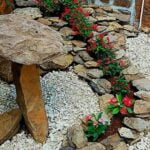Landscaping block ideas are a great way to enhance the visual appeal of your outdoor space. Whether you’re looking to create a stunning garden, build a retaining wall, or add a pathway to your yard, landscaping blocks offer endless possibilities for creative design. In this article, we’ll explore the world of landscaping blocks and provide you with inspiration and practical tips for incorporating them into your landscape projects.
Landscaping blocks, also known as concrete blocks or segmental retaining wall units, are versatile building materials commonly used in landscaping and hardscaping projects. They come in a variety of sizes, shapes, and textures, making them suitable for a wide range of applications. From creating raised flower beds to constructing decorative walls and walkways, landscaping blocks can be utilized in countless ways to transform your outdoor space.
In the following sections, we’ll guide you through the process of choosing the right landscaping blocks for your project, offer creative design ideas for using them in the garden, provide step-by-step instructions for installation, and share maintenance tips to ensure that your landscaping blocks remain in top condition.
Whether you’re a seasoned DIY enthusiast or new to landscaping design, this article will help you discover the potential of landscaping blocks and learn how to make the most of them in enhancing your outdoor environment.
Choosing the Right Landscaping Blocks for Your Project
When it comes to choosing the right landscaping blocks for your project, there are several factors to consider. First and foremost, you’ll want to think about the overall aesthetic you’re trying to achieve. For a more modern and clean look, concrete or smooth-faced blocks may be the best option. On the other hand, if you’re aiming for a more natural and rustic feel, weathered or tumbled blocks could be a better fit.
Another important consideration is the size and shape of the landscaping blocks. Larger blocks can create a more imposing and sturdy structure, while smaller ones can be used for intricate designs or detailing. Additionally, some projects may require specific shapes such as corner blocks or caps to finish off edges and corners seamlessly.
Lastly, take into account the practical aspects of your project. Will the landscaping blocks need to withstand heavy foot traffic? Do they need to endure harsh weather conditions? These questions can help guide you toward selecting blocks that are not only visually appealing but also durable and functional for their intended purpose.
Ultimately, choosing the right landscaping blocks for your project is a crucial step in achieving your desired landscape design. By considering factors like aesthetics, size and shape, as well as practicality, you can ensure that your chosen blocks will complement your overall vision effectively. Whether you’re building borders and edging, creating pathways and walkways, or constructing retaining walls, selecting the perfect landscaping blocks is key to bringing your outdoor space to life with style and functionality.
Creative Designs for Using Landscaping Blocks in the Garden
Landscaping blocks are versatile and can be used in various creative ways to enhance the aesthetics of your garden. Here are some creative designs for using landscaping blocks in the garden:
Raised Garden Beds
One popular way to use landscaping blocks in the garden is by creating raised garden beds. This not only adds visual interest to your garden but also provides a functional space for growing plants, flowers, and vegetables. You can stack landscaping blocks to create the desired height and shape for your raised garden beds.
Water Feature Surrounds
Another creative design idea for utilizing landscaping blocks in the garden is to use them to surround water features such as fountains or ponds. The natural, rustic look of landscaping blocks can complement the tranquility of water features and help define the space within your garden.
Decorative Planters
Using landscaping blocks to build decorative planters is an excellent way to add dimension and character to your garden. You can stack the blocks in different configurations and sizes to create unique planter designs, giving your garden a personalized touch.
These are just a few examples of how you can creatively incorporate landscaping blocks into your garden design. With some imagination and planning, you can transform your outdoor space into a beautiful and inviting oasis using these versatile building materials.
How to Install Landscaping Blocks
Landscaping blocks are a popular choice for adding structure and organization to outdoor spaces. Whether you’re creating a garden border, constructing a retaining wall, or building a pathway, installing landscaping blocks can be a straightforward DIY project with the right tools and materials. Here’s a step-by-step guide to help you install landscaping blocks for your next outdoor project.
Preparation
Before you begin the installation process, it’s important to prepare the area where the landscaping blocks will be placed. Clear the area of any existing plants, rocks, or debris to create a clean and even surface. Use a shovel or garden rake to level the ground and remove any obstructions that could interfere with the placement of the blocks.
Placement
Once the area is prepared, you can start placing the landscaping blocks according to your design plan. It’s essential to take accurate measurements and use a string line or chalk to mark the layout of your project. This will ensure that your landscaping blocks are installed in straight lines and at consistent heights.
Securing
After placing each landscaping block in its designated position, use a rubber mallet to tap them into place and ensure they are level. If necessary, add sand or gravel underneath the blocks to create a stable foundation. Once all the blocks are in place, use landscape adhesive to secure them together and prevent shifting over time.
By following these steps and paying attention to detail during installation, you can achieve professional-looking results for your landscaping block ideas while enhancing the overall look of your outdoor space.
Landscaping Block Ideas for Borders and Edging
Landscaping blocks can be a great addition to any garden or outdoor space, providing not only structure and definition but also a touch of style and sophistication. When it comes to borders and edging, landscaping blocks offer endless possibilities for creating a polished and cohesive look. Here are some landscaping block ideas for borders and edging that you can consider for your next outdoor project:
- Stacked Stone Border: Use landscaping blocks with a stacked stone design to create a natural and rustic border for your flower beds or garden paths. The irregular shapes and textures of the stones add a charming and organic touch to your landscape.
- Brick Edging: For a classic and timeless look, consider using brick-style landscaping blocks as edging for your lawn or garden beds. The warm hues of brick bring an inviting and traditional feel to your outdoor space.
- Curved Borders: Create fluid and graceful lines in your garden by using curved landscaping blocks for borders and edging. This approach adds visual interest and movement, making your landscape more dynamic.
Incorporating landscaping blocks into your borders and edging not only elevates the appearance of your outdoor space but also provides practical benefits such as preventing soil erosion, containing mulch, and keeping grass from encroaching on flower beds. With the right choice of landscaping blocks, you can achieve a professional-looking border or edging that enhances the overall aesthetics of your garden.
Whether you prefer a contemporary, traditional, or eclectic style for your outdoor area, there are numerous landscaping block ideas for borders and edging that can cater to different tastes and preferences. By exploring various designs and options, you can find the perfect landscaping block solution that perfectly complements the look you want to achieve in your landscape design project.
Using Landscaping Blocks for Retaining Walls
Retaining walls are an essential element in many landscaping projects, providing both function and aesthetic appeal to any garden or outdoor space. When utilizing landscaping block ideas for retaining walls, it is crucial to consider the overall design, practicality, and durability of the materials chosen.
One of the key factors in using landscaping blocks for retaining walls is selecting the right type of material. Popular choices include concrete blocks, natural stone, and brick pavers. Concrete blocks are known for their strength and versatility, making them ideal for retaining walls of varying heights and purposes. On the other hand, natural stone provides a more textured and rustic look, creating a visually appealing addition to any landscape design.
In addition to the material, it’s important to think about the design and layout of the retaining wall. Whether it’s a straight or curved wall, terraced levels, or incorporating steps within the structure – there are numerous creative designs that can be achieved using landscaping blocks. For example, creating a tiered retaining wall with different colored blocks can add depth and visual interest to an otherwise flat landscape.
When installing landscaping blocks for retaining walls, make sure to follow a step-by-step guide to ensure proper construction that will withstand soil pressure and erosion over time. Proper drainage must also be considered in order to avoid water accumulation behind the wall which can cause structural issues in the long run.
| Landscaping Block Ideas for Retaining Walls | Description |
|---|---|
| Tiered Garden Wall | A multi-level retaining wall using different colored blocks for added visual appeal. |
| Natural Stone Retaining Wall | A more organic look using irregularly shaped stones placed together like a puzzle. |
| Curved Landscape Wall | An elegant design that adds fluidity to the landscape compared to traditional straight retaining walls. |
Landscaping Block Ideas for Pathways and Walkways
Landscaping block ideas can significantly enhance the appeal of your pathways and walkways, creating a beautiful and organized outdoor space. When choosing landscaping blocks for these areas, it’s essential to consider durability, aesthetics, and ease of maintenance. Popular options include concrete pavers, natural stone pavers, and brick pavers. These materials are not only durable but also come in a variety of shapes, sizes, and colors to complement any landscaping design.
Creative designs for using landscaping blocks in pathways and walkways include different patterns such as herringbone, running bond, or basket weave. Additionally, incorporating different colored blocks into the design can create a unique visual effect that adds character to your outdoor space. Another popular trend is using mixed materials like combining brick with pebbles or gravel to add texture and visual interest.
Installing landscaping blocks for pathways and walkways involves careful planning and preparation. The area needs to be properly leveled and compacted before laying the blocks to ensure stability and prevent shifting over time. Proper base installation is crucial for longevity and performance of the pathway or walkway. Using landscaping fabric underneath the blocks can help minimize weed growth between the joints.
| Landscaping Block Ideas for Pathways/Walkways | Description |
|---|---|
| Concrete Pavers | Durable option available in various shapes, sizes, and colors. |
| Natural Stone Pavers | Adds a rustic, natural look to pathways; comes in different textures like flagstone or cobblestone. |
| Brick Pavers | Timeless look that offers versatility in design with various patterns available. |
Tips for Maintaining and Caring for Landscaping Blocks
Landscaping blocks are a popular and versatile choice for adding structure and visual interest to gardens and outdoor spaces. Once you have completed your landscaping project using blocks, it’s important to properly maintain and care for them to ensure they continue to enhance your landscape for years to come.
Regular Cleaning
One of the most important aspects of maintaining landscaping blocks is regular cleaning. Over time, dirt, grime, and moss can accumulate on the surface of the blocks, detracting from their visual appeal.
To keep your landscaping blocks looking their best, regularly sweep away debris and use a pressure washer or hose with a high-powered nozzle attachment to remove any stuck-on dirt or grime. For stubborn stains, a gentle scrub with a mild detergent can help restore the blocks to their original condition.
Weed Control
Another important aspect of caring for landscaping blocks is keeping weeds at bay. Weeds can quickly take hold in the gaps between blocks, compromising the overall appearance of your landscaping project. To prevent weeds from growing between your blocks, consider using a weed barrier fabric during installation or applying an herbicide as needed. Regularly inspect the areas around your landscaping blocks and promptly deal with any emerging weeds to maintain a clean and tidy look.
Sealing
To prolong the life and appearance of your landscaping blocks, consider applying a sealant. Sealing your blocks can help protect them from moisture damage, color fading, and efflorescence (the white chalky residue that sometimes appears on concrete surfaces). Be sure to choose a sealant specifically designed for use on landscaping blocks and follow the manufacturer’s instructions for application. A properly applied sealant can help keep your landscaping block project looking like new for years to come.
By following these tips for maintaining and caring for your landscaping blocks, you can ensure that they remain an attractive and functional part of your outdoor space for years to come. Taking the time to clean, control weeds, and seal your landscaping blocks will pay off in the form of a beautiful and long-lasting landscape feature that enhances the overall appeal of your property.
Conclusion
In conclusion, landscaping blocks offer a versatile and practical solution for enhancing your outdoor space. Whether you are looking to create borders and edging, build retaining walls, or design pathways and walkways, landscaping blocks provide endless possibilities for transforming your garden. By carefully selecting the right type of landscaping block for your project and utilizing creative designs, you can truly elevate the visual appeal of your landscape.
When it comes to landscaping block ideas, the key is to think outside the box. Consider mixing different types of materials such as concrete, natural stone, or brick to add depth and texture to your design. You can also experiment with various patterns and laying techniques to create unique and eye-catching features in your garden. Additionally, incorporating elements such as lighting or planting beds can further enhance the beauty of your landscaping blocks.
Furthermore, proper installation and maintenance are essential for ensuring the longevity of your landscaping blocks. By following a step-by-step guide for installation and implementing regular care practices, you can preserve the integrity of your landscaping features for years to come.
With these considerations in mind, incorporating landscaping blocks into your outdoor design is an excellent way to add value and aesthetic appeal to your property. Whether you are a seasoned gardener or a novice landscaper, there are endless opportunities for using landscaping blocks to enhance the beauty of your outdoor space.
Frequently Asked Questions
What Do You Put Under Landscape Blocks?
When installing landscape blocks, it’s important to properly prepare the area underneath them. Typically, a base of compacted gravel is placed underneath landscape blocks to provide stability and proper drainage. This will help prevent shifting or sinking over time and create a durable foundation for the blocks.
What Are Landscape Blocks Called?
Landscape blocks are also known as retaining wall blocks or concrete masonry units (CMUs). These pre-cast concrete blocks are specifically designed for creating retaining walls, garden beds, and other landscaping features. They come in a variety of sizes, shapes, and colors to suit different aesthetic preferences.
How Many Landscape Blocks Do I Need?
The number of landscape blocks needed will depend on the size of the project and the dimensions of the blocks being used. Before starting a project, it’s important to calculate the total area that needs to be covered and then determine how many landscape blocks are required to cover that area based on their size and spacing.
It’s also a good idea to account for extra blocks to accommodate any cutting or fitting that may be necessary during installation.

Welcome to my gardening blog! I am passionate about plants and enjoy sharing my knowledge and experiences with others. In this blog, I will write about everything related to gardening, from tips on how to get started to updates on my own garden projects.





